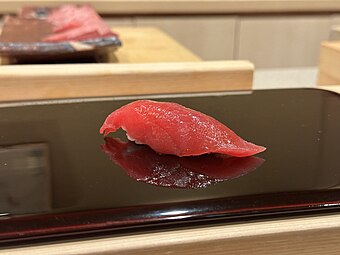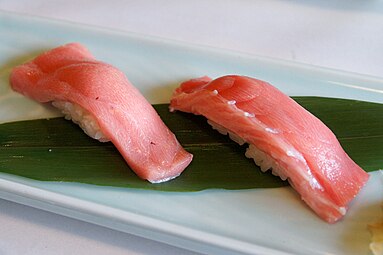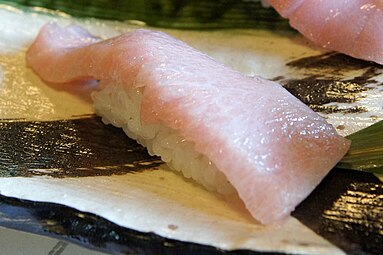Toro ( Japanese: トロ, translating to "melting") is the fatty meat of tuna [1] [2] [3] served as sushi [4] or sashimi. It is usually cut from the belly or outer layers of the Pacific bluefin tuna (the other fish known for similar meat is bigeye tuna). [5] Good-quality toro is said to create a "melting" sensation once placed in the mouth. [1]
The cut is very desirable and has the highest price in the areas of the world where consumers like fatty fish (Japan, USA). [1] This preference is a relatively new phenomenon: prior to the Second World War toro was considered to be of low value and frequently simply discarded. [6]
Toro is subdivided into two grades: [7]
- Ōtoro (大トロ, "big toro") – very fatty cut from the area belly area just behind the head, tender and rich; expensive and usually served on special occasions; [4]
- Chūtoro (中トロ, "medium toro") – less fatty cut made from the areas closer to the tail; the fat content in the case of bigeye reaches 25%. [5]
-
Akami (lean tuna)
-
Chūtoro (medium fatty toro)
-
Ōtoro (very fatty toro)
The meat from the inner layers of the fish, called akami (赤身), [1] is more reddish and has less fat (with 14% fat in bigeye). [5]
Toro from wild tuna is a seasonal product: winter tuna is considered to be better, summer one is less fatty. [8]
- ^ a b c d Van Kampen-Lewis 2008, p. 25.
- ^ Fraioli, James O.; Sato, Chef Kaz (2008). The Complete Idiot's Guide to Sushi and Sashimi. New York, NY: Alpha Books. ISBN 978-1-59257-782-8. Archived from the original on 2016-11-30. Retrieved 2016-02-19.
-
^
"Sushi Menu". Sushi Encyclopedia. 2007.
Archived from the original on 20 May 2017. Retrieved 12 February 2016.
The sushi menu consists of basic Edo style sushi and they are grouped in their styles.
- ^ a b Smith, Andrew F. (2012). American Tuna: The Rise and Fall of an Improbable Food. University of California Press. p. 95. ISBN 9780520954151.
- ^ a b c Ashenden & Kitson 1987, p. 23.
- ^ Bergin & Haward 1996, p. 12.
- ^ Van Kampen-Lewis 2008, pp. 25–26.
- ^ Shoji 1972, p. 12.
- Van Kampen-Lewis, Stephen (August 2008). An analytical approach to likely sources of distribution for a hypothetical tuna farm based in Hawaii (M.B.A. thesis). University of Hawaii at Manoa.
- Ashenden, Geoffrey P.; Kitson, Graham W. (1987). The Japan tuna market. Pacific Islands Development Program.
- Bergin, A.; Haward, M.G. (1996). Japan's Tuna Fishing Industry: A Setting Sun Or New Dawn? (in Malay). Nova Science Publishers. ISBN 978-1-56072-241-0. Retrieved 2024-07-11.
- Shoji, Tosuke (March 1972). Study on the Economic Effect of the Investment for Modernistic Equipment in Japanese Far Sea Tuna Industries (PDF). National Marine Fisheries Service.
Toro ( Japanese: トロ, translating to "melting") is the fatty meat of tuna [1] [2] [3] served as sushi [4] or sashimi. It is usually cut from the belly or outer layers of the Pacific bluefin tuna (the other fish known for similar meat is bigeye tuna). [5] Good-quality toro is said to create a "melting" sensation once placed in the mouth. [1]
The cut is very desirable and has the highest price in the areas of the world where consumers like fatty fish (Japan, USA). [1] This preference is a relatively new phenomenon: prior to the Second World War toro was considered to be of low value and frequently simply discarded. [6]
Toro is subdivided into two grades: [7]
- Ōtoro (大トロ, "big toro") – very fatty cut from the area belly area just behind the head, tender and rich; expensive and usually served on special occasions; [4]
- Chūtoro (中トロ, "medium toro") – less fatty cut made from the areas closer to the tail; the fat content in the case of bigeye reaches 25%. [5]
-
Akami (lean tuna)
-
Chūtoro (medium fatty toro)
-
Ōtoro (very fatty toro)
The meat from the inner layers of the fish, called akami (赤身), [1] is more reddish and has less fat (with 14% fat in bigeye). [5]
Toro from wild tuna is a seasonal product: winter tuna is considered to be better, summer one is less fatty. [8]
- ^ a b c d Van Kampen-Lewis 2008, p. 25.
- ^ Fraioli, James O.; Sato, Chef Kaz (2008). The Complete Idiot's Guide to Sushi and Sashimi. New York, NY: Alpha Books. ISBN 978-1-59257-782-8. Archived from the original on 2016-11-30. Retrieved 2016-02-19.
-
^
"Sushi Menu". Sushi Encyclopedia. 2007.
Archived from the original on 20 May 2017. Retrieved 12 February 2016.
The sushi menu consists of basic Edo style sushi and they are grouped in their styles.
- ^ a b Smith, Andrew F. (2012). American Tuna: The Rise and Fall of an Improbable Food. University of California Press. p. 95. ISBN 9780520954151.
- ^ a b c Ashenden & Kitson 1987, p. 23.
- ^ Bergin & Haward 1996, p. 12.
- ^ Van Kampen-Lewis 2008, pp. 25–26.
- ^ Shoji 1972, p. 12.
- Van Kampen-Lewis, Stephen (August 2008). An analytical approach to likely sources of distribution for a hypothetical tuna farm based in Hawaii (M.B.A. thesis). University of Hawaii at Manoa.
- Ashenden, Geoffrey P.; Kitson, Graham W. (1987). The Japan tuna market. Pacific Islands Development Program.
- Bergin, A.; Haward, M.G. (1996). Japan's Tuna Fishing Industry: A Setting Sun Or New Dawn? (in Malay). Nova Science Publishers. ISBN 978-1-56072-241-0. Retrieved 2024-07-11.
- Shoji, Tosuke (March 1972). Study on the Economic Effect of the Investment for Modernistic Equipment in Japanese Far Sea Tuna Industries (PDF). National Marine Fisheries Service.


